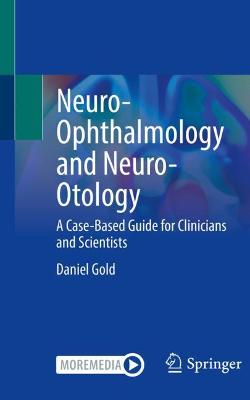(To see other currencies, click on price)
MORE ABOUT THIS BOOK
Main description:
This book combines the complexities of neuro-ophthalmologic and neuro-otologic disorders into one concise guidebook. It focuses on the basics of these two challenging subspecialties, encountered by the neurologist, ophthalmologist, otolaryngologist, neurosurgeon, emergency medicine provider, and others.
Comprehensive and succinct, the book contains chapters examining representative case vignettes that highlight typical historical elements and exam findings that aid in diagnosing a specific disease, disorder, or syndrome. Before each heading, chapters offer a brief review of relevant anatomy, physiology, and examination techniques. Additionally, symptom-based tables guide the practitioner to a focused history and examination for rapid real-time triage and diagnosis.
Practical and case-based, Neuro-Ophthalmology and Neuro-Otology is an invaluable resource for practitioners, trainees, and residents in various fields.
Contents:
SECTION 1 - PUPILS, EYELID, ORBIT, VISUAL PATHWAYS
1) Pupil
i. Anatomy, physiology, examination techniques
ii. Horner syndrome
iii. 3rd nerve palsy
iv. Tonic pupil
2) Eyelid
i. Anatomy, physiology, examination techniques
ii. Myasthenia gravis
iii. Neurologic eyelid retraction (dorsal midbrain syndrome)
iv. Eyelid spasms
3) Orbit/globe
i. Anatomy, physiology, examination techniques
ii. Thyroid eye disease
iii. Eye pain (angle closure)
iv. Red eye (CCF)
4) Retina
i. Anatomy, physiology, examination techniques
ii. Central retinal artery occlusion
iii. Photopsias
5) Optic nerve
i. Anatomy, physiology, examination techniques
ii. NAION
iii. Giant cell arteritis
iv. Optic neuritis
v. Papilledema
6) Chiasm
i. Anatomy, physiology, examination techniques
ii. Apoplexy
iii. Pituitary tumor
7) Retro-chiasmal
i. Anatomy, physiology, examination techniques
ii. Optic tract
iii. Lateral geniculate nucleus
iv. Optic radiations
v. Occipital lobe
8) Higher cortical visual disorders
i. Posterior cortical atrophy
ii. Hallucinations
iii. Cortical blindness
SECTION 2 - MOTILITY & OCULAR MOTOR DISORDERS
9) Subarachnoid space, cavernous sinus, orbital apex
i. Subarachnoid space (multiple neoplastic cranial neuropathies)
ii. Cavernous sinus (Tolosa Hunt)
iii. Orbital apex (infectious)
10) Medulla
i. Wallenberg syndrome
ii. Chiari
11) Pons
i. MLF
ii. One-and-a-half syndrome
iii. 6th nerve
12) Midbrain
i. Parinaud syndrome
ii. Nuclear 3rd nerve palsy
iii. 4th nerve
13) Basal ganglia
i. Progressive Supranuclear Palsy
ii.Parkinson's disease and convergence insufficiency
iii. Huntington's disease
14) Cerebellum
i. Paraneoplastic (opsoclonus)
ii.Spinocerebellar ataxia (downbeat nystagmus)
SECTION 3 - VESTIBULAR DISORDERS
15) Acute vestibular syndrome - Anatomy, physiology, examination techniques
i. Vestibular neuritis
ii. Stroke
16) BPPV - Anatomy, physiology, examination techniques
i. Posterior Canal
ii. Horizontal Canal
iii. Central Positional
17) Vestibular Migraine
i. Dissection mimic
18) Meniere
i. AICA mimic
19) Chronic vestibular
i. Persistent Postural Perceptual Dizziness
ii. Mal de Debarquement Syndrome
20) Episodic vestibular
i. Superior Canal Dehiscence Syndrome
ii. Vestibular paroxysmia
iii. TIA
SECTION 4 - NYSTAGMUS & OSCILLOPSIA
21) Anatomy, physiology, examination techniques
22) Nystagmus
i. Downbeat nystagmus
ii. Upbeat Nystagmus
iii. Periodic Alternating Nystagmus
iv. Oculopalatal Tremor
v. Multiple Sclerosis-related Pendular
vi. Gaze-evoked versus physiologic end point nystagmus
23) Saccadic intrusions
i. Square Wave Jerks
ii. Opsoclonus/Ocular Flutter
24) Oscillopsia
i. Bilateral Vestibular Loss
ii.Nystagmus/oscillations
SECTION 5 - HELP ME NOW! A SYMPTOM BASED APPROACH
25) Vision loss
26) Anisocoria/fixed dilated pupil
27) Ptosis
28) Diplopia
29) Ophthalmoplegia
30) Abnormal eye movements
31) Acute prolonged vertigo
32) Episodic vertigo
33) Chronic dizziness
PRODUCT DETAILS
Publisher: Springer (Springer Nature Switzerland AG)
Publication date: January, 2022
Pages: None
Weight: 649g
Availability: Available
Subcategories: General, Neurology, Ophthalmology and Optometry, Otorhinolaryngology (ENT)

